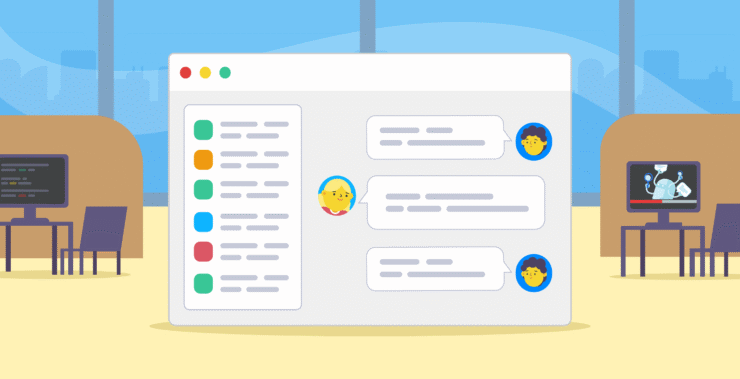An office is much like a living organism.
Every department, every role, and every individual functions as a vital part of that greater body. And while it may not have a literal brain, its communication system acts very much like a nervous system. It’s quietly ensuring that signals travel, tasks align, and responses are timely. When that system weakens, the entire operation begins to feel it. Disconnection spreads. Coordination collapses. Productivity, once fluid, becomes fractured.
That’s why a well-built office communication system is mission-critical. Especially now, when the very idea of “office” has evolved. Your team might no longer sit under one roof. They may be across cities, countries, or continents. Time zones usually shift. Schedules overlap. And yet, work must move forward — seamlessly, clearly, and in sync. Here, office communication systems become a foundation that keeps teams together, whether they are across the hall or across the world.
And this is where Chanty clearly proves its value. It brings clarity and cohesion to the modern workflow by offering a unified space where conversations, calls, and task tracking come together. Teams can connect through chat, audio, video, or even landline calls, choosing what fits the moment best. And with the built-in Kanban board, your team gets a visual map of every task, from the spark of a “to-do” to the satisfaction of “done.”
In the sections ahead, we’ll unpack what office communication systems really are, why they matter more than ever, and which tools stand out in a world where collaboration knows no boundaries.
Top 10 office communication systems
1. Chanty — All-in-one communication and collaboration hub with chat, calls, and a built-in Kanban board.
2. Slack — Fast-paced messaging platform with extensive integrations and threaded conversations.
3. Microsoft Teams — Robust communication tool deeply integrated with Microsoft 365, great for hybrid collaboration.
4. Google Workspace (Chat & Meet) — Lightweight messaging and video tools seamlessly built into the Gmail and Drive ecosystem.
5. Twist — Asynchronous team communication tool focused on calm, thread-based conversations.
6. Mattermost — Self-hosted communication platform tailored for technical teams with high-security needs.
7. Rocket.Chat — Secure, open-source messaging platform with full control over data and custom workflows.
8. ClickUp Chat — Task-centered chat integrated directly into project management for context-rich collaboration.
9. Notion — All-in-one workspace blending team notes, knowledge bases, and lightweight communication.
10. Loom — Video messaging tool ideal for quick visual updates and async team communication.
What is an office сommunication system?
An office communication system is the system that maintains information flowing inside your company. It’s not merely talking or calling. It’s the whole setup — tools, habits, and processes — that allows individuals to stay connected, share information, make choices, and get things done.
Consider it the internal wiring of your business. It connects people to people, people to data, and people to their daily goals. And it works regardless of where your team happens to be located, in the same room or spread across nations and time zones.
The system often has a few base layers:
- First, real-time communication. That’s your instant messaging, voice calls, and video calls. It’s what teams use to get things done quickly, resolve issues, and maintain momentum.
- Then there’s asynchronous communication. That includes emails, comments, recorded messages, or task updates. Those allow people to respond when it suits them, without holding things up.
- Then there’s information sharing and documentation. These tools help maintain and keep organized knowledge—like shared folders, cloud documents, internal wikis, and pinned messages. When used properly, they help with not having to search forever and answering the same questions repeatedly.
- Another level is task and project management. This is where your work is tracked. From high-level goals to day-to-day tasks, this part of the system keeps your team in harmony.
- And finally, there are integrations. These connect your communications with calendars, CRM, HR software, or whatever your team uses. It makes the whole system more silky, with fewer tabs and less copy-pasting by hand.
So no — it’s not just a chat app. A proper office communication system revolutionizes how your team works together. It keeps everything sorted, reduces confusion, and prevents anything important from slipping through the cracks.
In distributed or hybrid setups, this system is even more critical. It must operate from location to location, time zone to time zone, language to language, and schedule to schedule. That’s why flexibility, simplicity, and ease are so critical.
When communications function, work functions. When they don’t, nothing else does. That’s why choosing and building the right system is no longer a nice-to-have; it’s a must.
Let’s dive into the top options that can help you build a stronger, more connected team.
Chanty
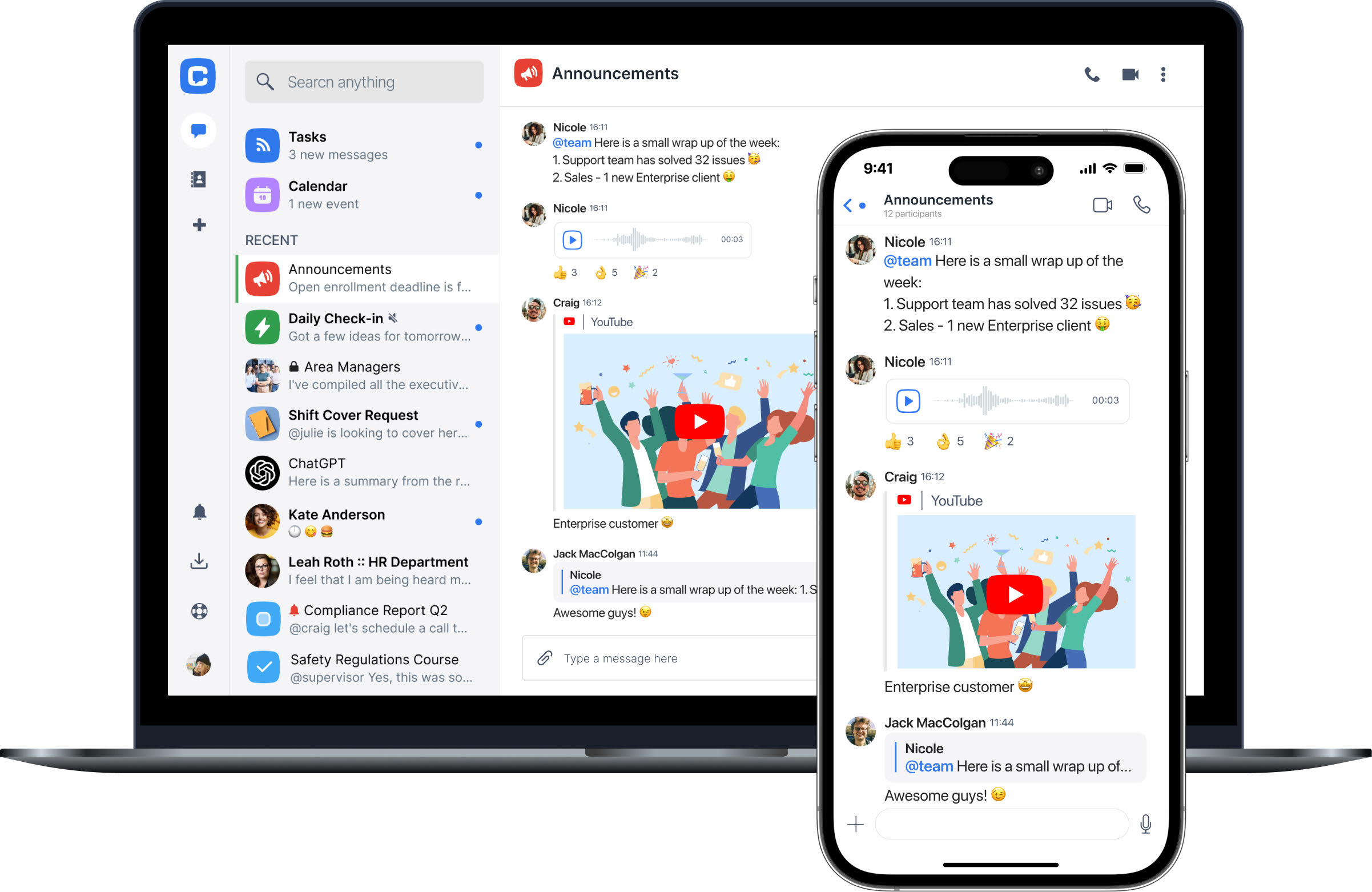
Chanty is more than just a team messenger. It’s your communications system, collaboration hub, and control panel — all within one simple roof. Built for teams who want to stay connected without the chaos, Chanty brings order to your workday and peace to your workflow.
Say goodbye to the annoying pinging from a dozen different tools. With Chanty, you manage your notifications your own way. Adiós to the fatigue and stress of being always plugged in from dawn till dusk. Stay on top with organized discussions and topic-related channels that keep your conversations focused and on point.
Want to find that one file from a month or two ago? No more digging through threads. Our genius search gets you there in seconds — and now even within individual conversations.
Want your message to reach the right people? Just @mention and get it directly to them. Need to ensure significant channels remain clean and readable? Admins can control posting rights so only significant updates are posted, and others can respond using quick reactions — no clutter, no distractions.
Discuss project details through voice or video calls, and when someone is offline, call their landline directly with a few clicks. Chanty offers transparent international rates, including dial-in rates for nearly all countries on earth.
And of course, track all tasks from “to do” to “done” through our built-in Kanban board. See who’s doing what and how far they got — all at once.
On top of that, your information remains secure. Chanty is compliant with leading security standards, has two-factor authentication, and never transfers your team’s personal data to third parties. What happens in Chanty — stays in Chanty.
Chanty is the office communication platform that ties everything together. Secure, integrated, simple to use — and constantly improving to suit your team’s requirements.
Slack
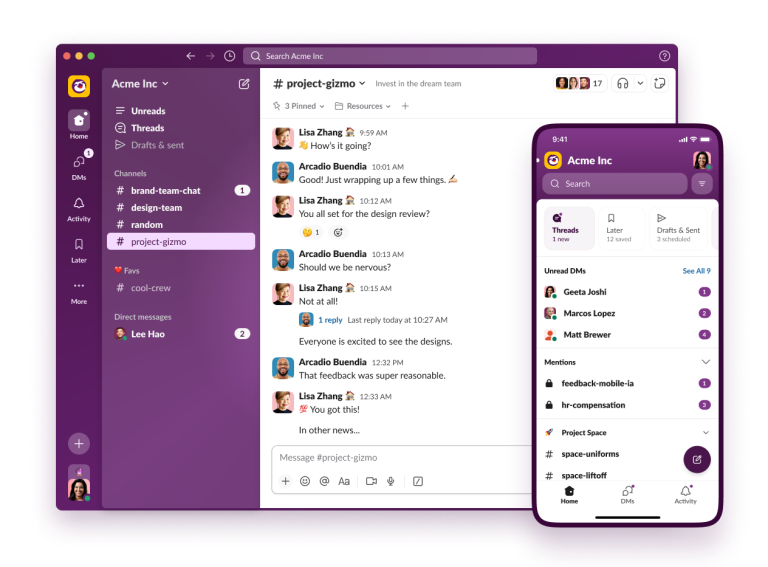
Slack has been among the top office communication tools for teams for years. It is a mix of chat, file sharing, integrations, and a simple interface that many find easy to use. Its channel-based structure allows it to be easy to keep conversations tidy by topic, project, or team — keeping it organized when used correctly.
With Slack, you can connect immediately via messages, audio huddles, or video calls. The solution also provides extensive integrations with third-party software, from calendars to project managers, positioning it as a strong contender for complex workflows.
The search is sharp, and with pinned messages and customizable notifications, teams can create a system that works at their own speed. @Mentions keep key updates from falling through the cracks, and threaded responses keep discussions organized.
To that end, many users find that Slack gets cumbersome and overwhelming in the long term. The sheer number of messages received through busy channels can lead to notification overload with large teams. Its free tier has limitations, including message history restrictions and limited file storage, which can put growing teams on a paid tier sooner than they wish to.
Despite Slack being very flexible and well-supported, some teams end up dealing with too many add-ons or with too much looseness without requiring more tools.
However, for many great organizations, Slack remains a strong and cozy spot to link, collaborate, and get the beat of what unfolds each day.
Microsoft Teams
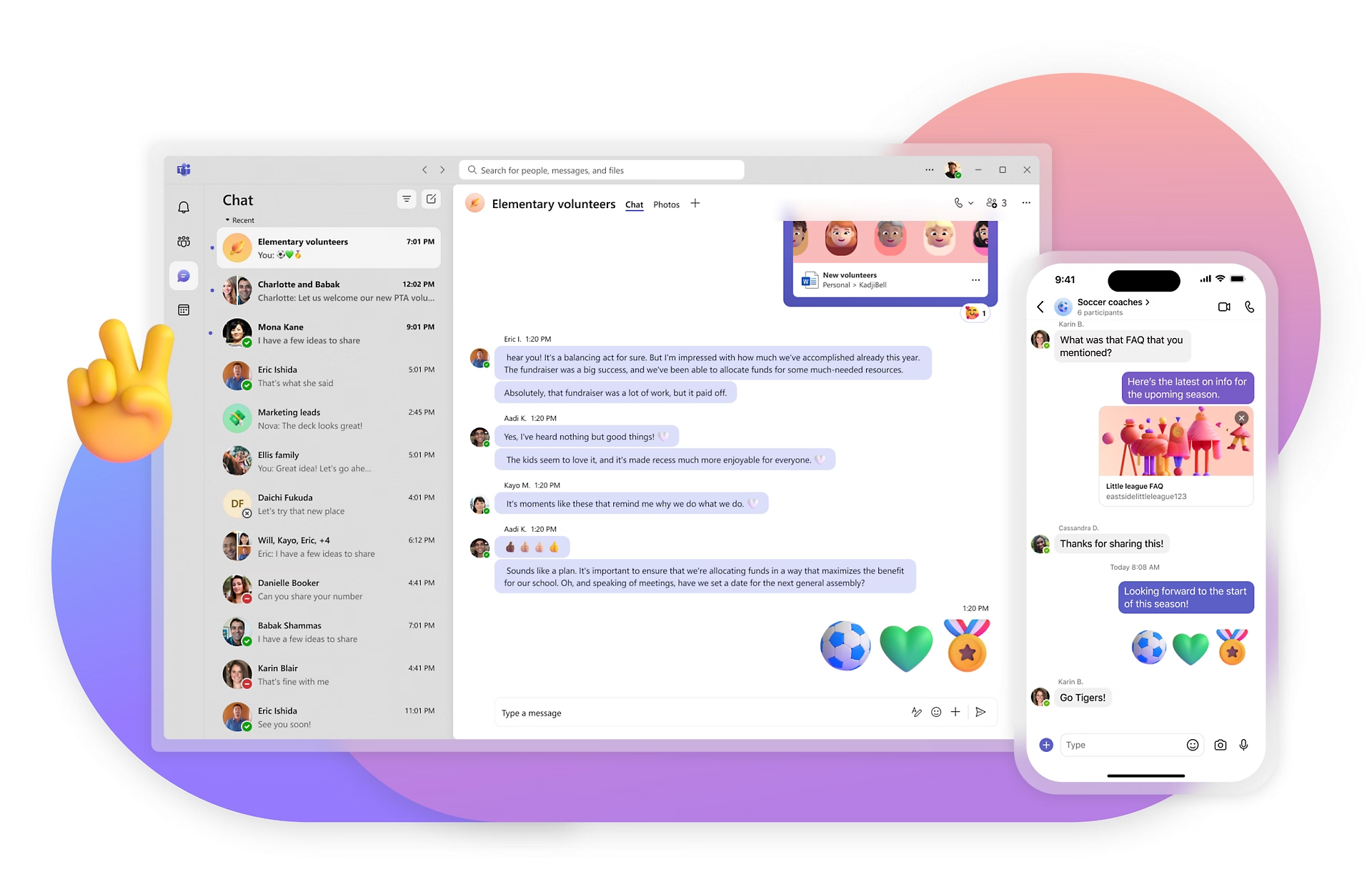
Microsoft Teams stands as a solid choice for businesses that rely on Microsoft 365. It’s more than a chat tool — it’s a full communication and collaboration hub. Everything’s under one roof: messaging, video calls, file sharing, scheduling, and live document editing.
For remote and hybrid teams, it helps bring structure back. Channels and group chats keep everyone looped into the right conversations. Real-time co-editing in Word or Excel cuts down on messy file versions. And with everything connected — Outlook, OneDrive, SharePoint — teams can focus instead of juggling tabs and tools.
It’s also a smart move budget-wise. Using Teams means you likely don’t need to pay for extra tools like Zoom, Dropbox, or even Slack. Everything’s baked into the Microsoft subscription, which simplifies IT costs and onboarding.
Security here is also a strong point. Microsoft keeps your data inside a secure cloud environment with enterprise-grade protections. Admins can control permissions, retention policies, and compliance settings with precision.
New hires onboarding is quick. The interface, while dense at first glance, is consistent with other Microsoft apps. Most users can find their footing fast and jump into their role from day one.
Still, it’s not perfect. The app can feel slow and bloated, especially on older devices. Notifications aren’t always easy to manage. And if your team isn’t already deep into the Microsoft ecosystem, the tool can feel less flexible compared to more lightweight options.
But for teams that want an all-in-one workspace — with strong security, seamless collaboration, and native integration across tools — Teams delivers a stable and unified experience.
Google Workspace
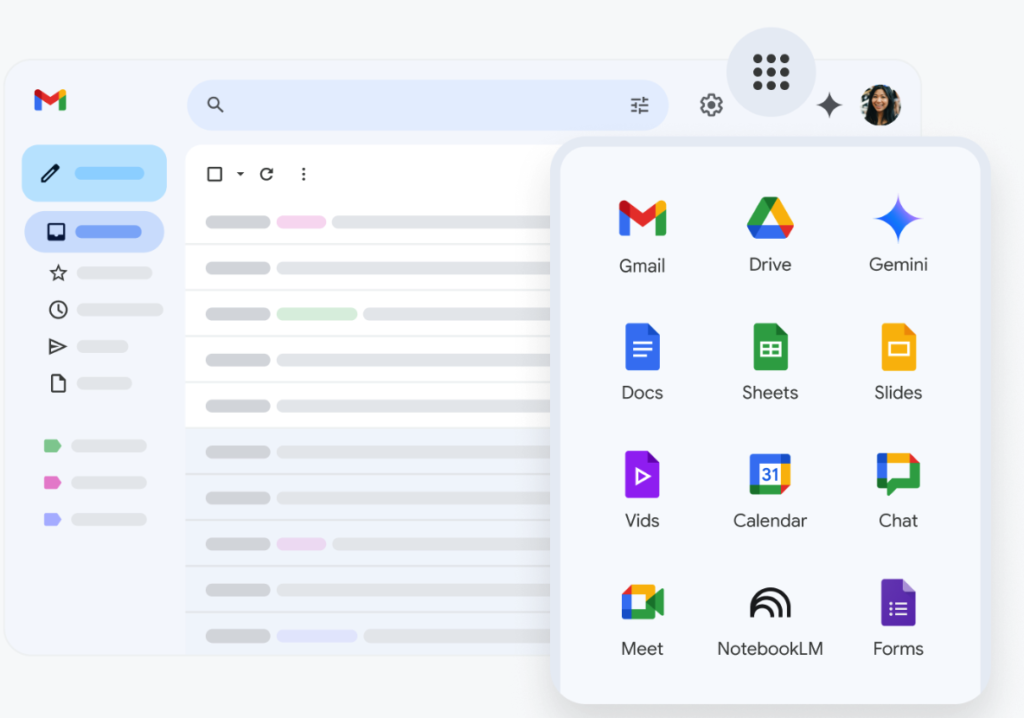
Google Workspace is a communications platform that feels natural to teams already on Gmail, Google Docs, and Google Calendar. It integrates Google Chat, Google Meet, and shared Drives into a cloud platform, and moving between messaging, meetings, and collaboration is effortless.
Google Chat enable to set individual and group chats, grouped into spaces that assist with keeping long-term themes separate. Google Meet is easy and quick, deeply integrated with Calendar and Gmail, so inviting and attending video calls is seamless — particularly for teams that are already in the Google environment.
Real-time editing in Docs, Sheets, and Slides ensures seamless collaboration. Since everything is saved to the cloud, you never experience version confusion or missing files. And Google’s powerful search applies to chats, emails, and docs, so you can quickly get what you’re looking for.
For remote and hybrid teams, Workspace has a simple-to-use interface that’s intuitive. New team members can jump right in and begin contributing on day one, without having to learn a new system.
On the negative side, Google Chat’s features for communication aren’t as deep or configurable as in some dedicated solutions. Threading in conversations can be confusing, and notifications occasionally come across as rudimentary. Working within complex organizational structures or maintaining high levels of engagement in multiple areas can be difficult.
Twist
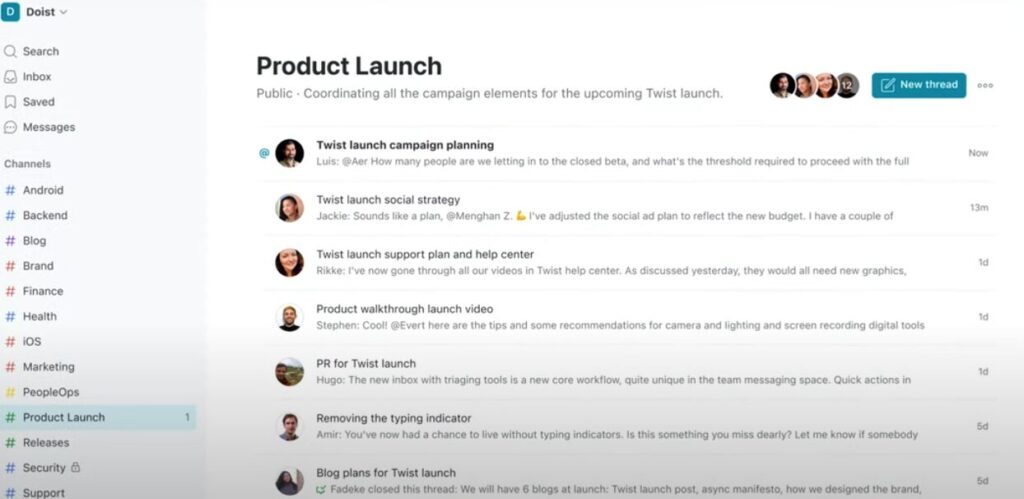
Twist is another way of communicating in the office. Instead of speed-based chat, it organizes conversation into simple-to-track, thread-based dialogue designed to cut through the noise and allow focus. It’s perfect for groups that must escape distractions and work more intentionally.
In essence, Twist replaces instant chat with neatly threaded conversations. Each message starts a topic, and replies stay neatly within it. This makes it simple to track ideas over time — very helpful for dispersed teams or projects with multiple time zones.
The site keeps notifications in check, encouraging async communication and thoughtful responses. You also get team channels, direct messages, and integration with such apps as GitHub, Google Drive, and Todoist (same family).
Twist’s clean, distraction-free UI is clear and calm. It doesn’t try to do everything at once. It’s focused, tranquil, and respectful of your time.
On that basis, however, less frenetic pace and lack of live urgency might be a poor match for high-speed operations. Live chat teams will be too disconnected. Its functionality set is also slimmer — voice and video calls are not native, and some users would like the platform to offer more customization or richer integrations.
Still, for those teams that appreciate clarity over chaos, and need a tool that facilitates async collaboration, Twist provides a effortless and focused solution to office communication.
Mattermost
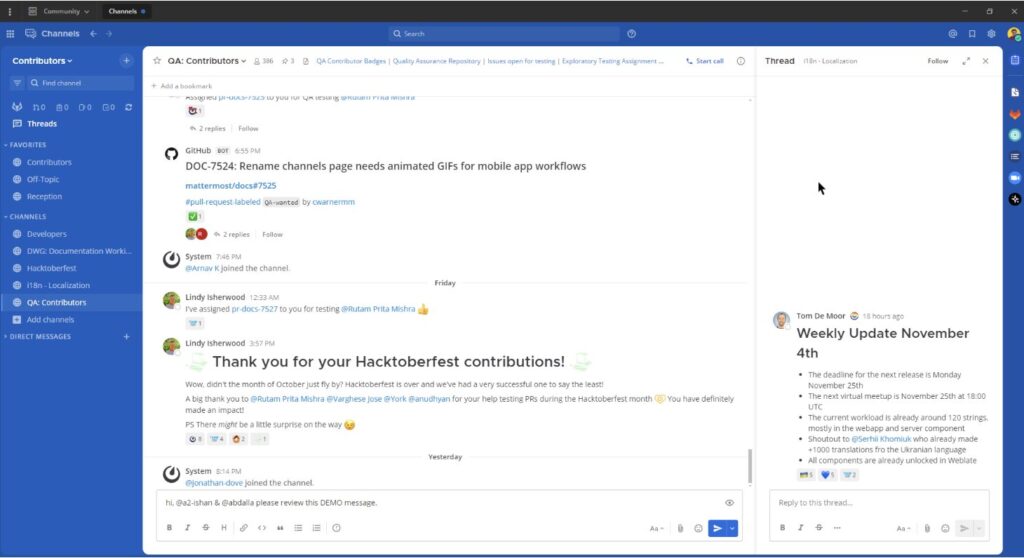
Mattermost is a workplace communication platform that stands out by its focus on privacy, customization, and control. It’s an open-source solution, which means you can host it on your own servers and customize it to your organization’s specific needs — so it’s a solid choice for companies with strict data policies or technical infrastructure already established.
The core experience is identical to Slack: channel-based messaging, direct messages, threads, file sharing, and strong search. But Mattermost goes an extra mile for dev teams with features like code snippet sharing, slash commands, and deep integrations with developer tools like Jira, GitLab, and Jenkins.
Its interface is clean and intuitive, it can even be already familiar, especially for teams transitioning from Slack. Administrators are given granular control over permissions, compliance policies, and user management. Self-hosting or cloud deployment is also possible, depending on your infrastructure.
Nevertheless, Mattermost is not for everybody. It requires greater technical involvement, especially if self-hosted. Configuration and maintenance may be challenging for teams without particular IT resources. Its desktop and mobile clients, while functional, sometimes lag behind their mainstream counterparts in polish and responsiveness.
Moreover, for non-technical teams, especially those who want plug-and-play simplicity, Mattermost might appear too technical or over-engineered.
However, for security-concerned organizations, especially in regulated industries or developer-heavy ecosystems, Mattermost stand out as a secure and flexible alternative to popular options — without compromising ownership or control.
RocketChat
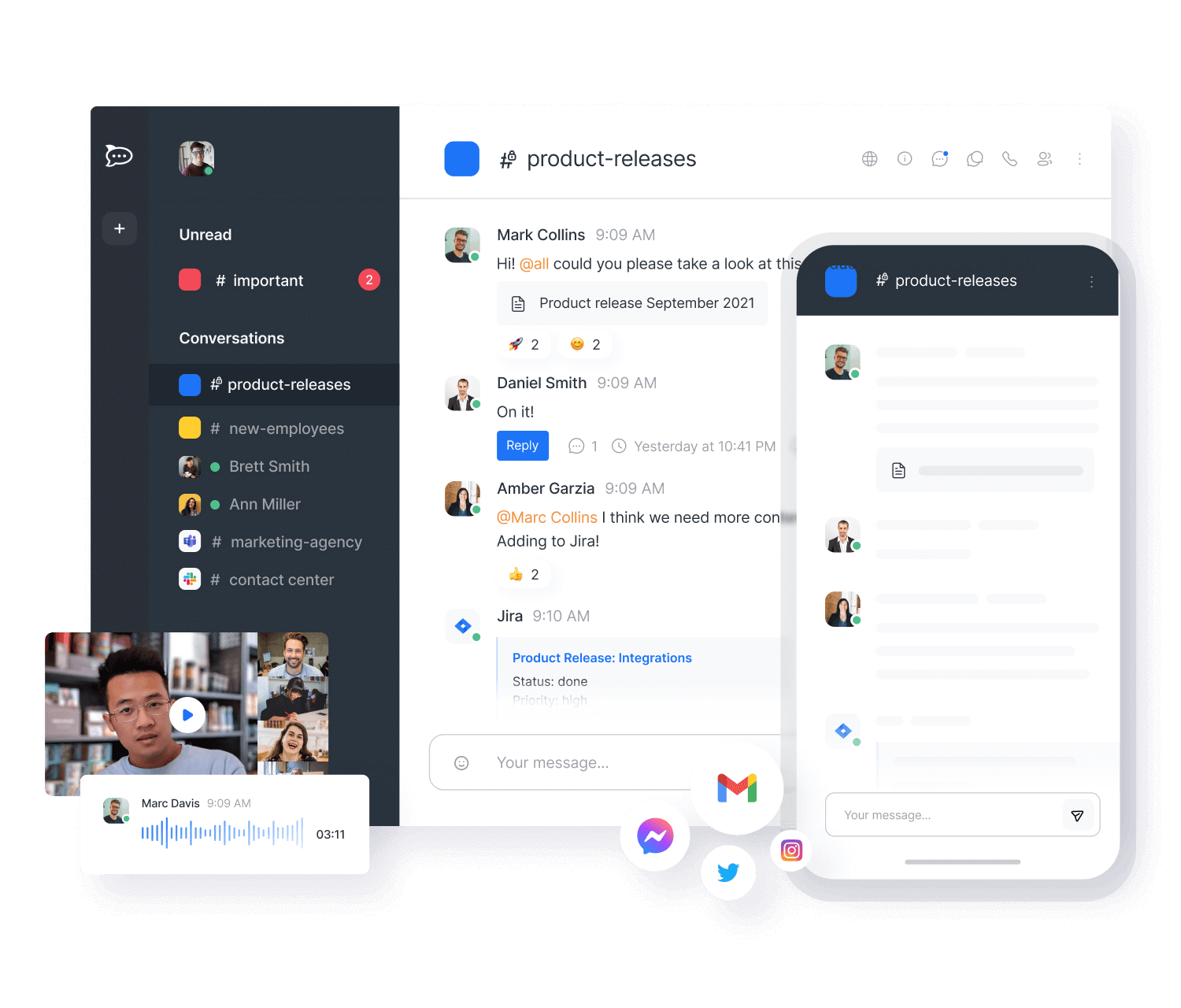
Rocket.Chat is a free and open-source office communication system for teams that need flexibility, privacy, and full control over their data. With features that mirror the likes of industry giants such as Slack, it offers real-time messaging, file sharing, voice and video calling, and channel-based communication — while enabling organizations to host the platform on their servers or use Rocket.Chat’s cloud.
It’s especially well-suited for industries where data compliance and self-hosting are critical — such as government, healthcare, and finance. Admins can customize everything from authentication methods to integrations, and even the UI if needed. You’ll also find end-to-end encryption options, audit logs, and role-based access control.
Rocket.Chat also offers omnichannel communication, so teams can manage messages not just internally, but also from customers via email, SMS, WhatsApp, or social media — all in one interface. For teams that manage customer support or field service, this can be a tremendous advantage.
That said, Rocket.Chat isn’t the most plug-and-play option. Its flexibility comes with a technical overhead, especially when self-hosted. Non-technical teams may find the setup and configuration process demanding. Its interface, while functional, isn’t as polished as mainstream tools, and performance can vary depending on deployment quality.
Its app marketplace and integration possibilities are growing but are still smaller than those of larger rivals like Slack or Microsoft Teams. And while it includes basic task tracking, it lacks built-in project management features like Kanban boards or deeper collaboration tools.
However, for security-conscious teams that require full control without sacrificing core communication functionality, Rocket.Chat delivers a solid and highly configurable experience.
ClickUp Chat
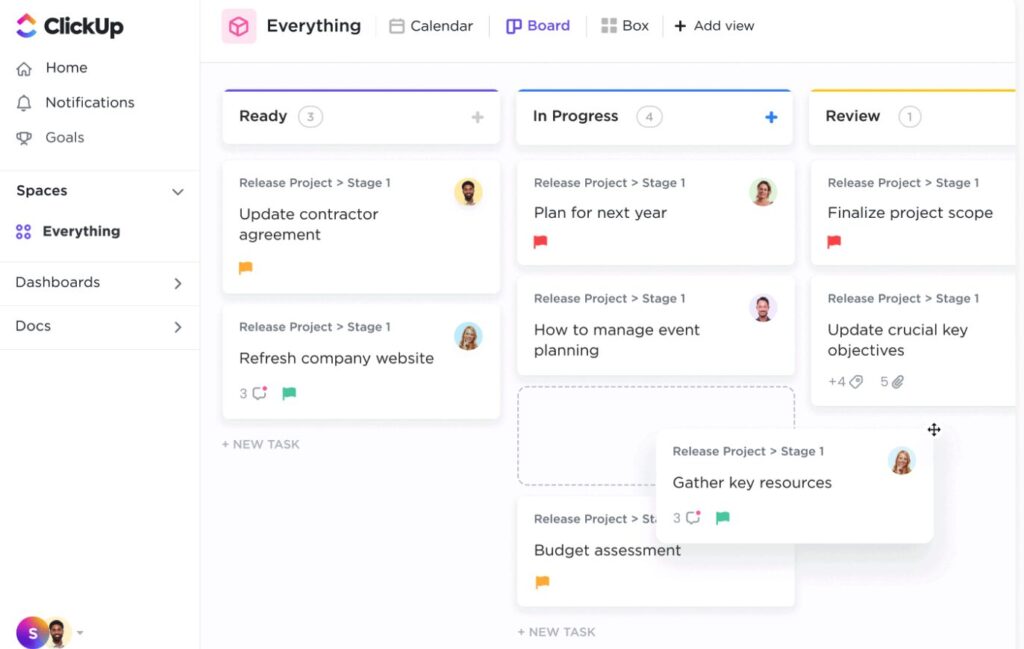
ClickUp Chat is not a standalone messaging tool — it’s built into ClickUp’s all-encompassing all-in-one productivity platform. With a task and project management focus, its chat functionality allows in-house communication to be closely tied to what work is being done.
You may set up chat views in any workspace or task folder, and keeping the conversation in context is simple. The minimal chat window offers text messages, @mentions, emojis, file sharing, and embedded link to a task. It’s especially handy when you need to discuss work where the work lives — no need to tab-switch.
The strength of ClickUp is the integration between chats, tasks, docs, and dashboards. You can turn a message into a task instantly or include follow-ups within the thread. This is how teams remain on task and do not lose action items in endless threads.
However, ClickUp Chat is limited compared to dedicated office communication tools. It lacks advanced features like voice or video calls, huddles in real-time, or complete notification customization. Furthermore, the discussions can get hard to track in heavy chats, especially since it lacks threading support like Slack or Twist.
For projects already in progress with ClickUp, though, its chat is an available, built-in option for staying in contact without needing a separate tool. But for firms seeking a robust, independent communication system, ClickUp Chat may be too limited or restrictive.
Bottom line: it’s a handy add-on for task-focused teams — not a full replacement for an integrated office communication system.
Notion
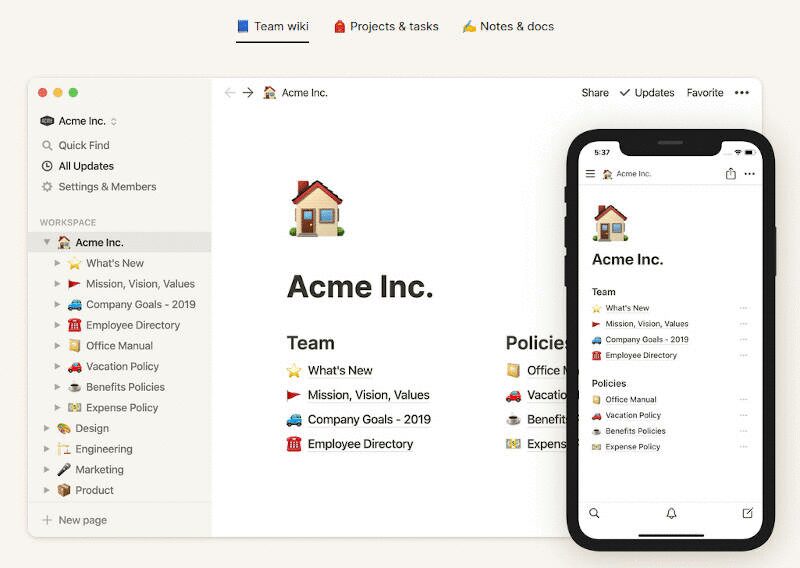
Notion is perhaps best known as a workspace and knowledge management tool, but it is increasingly used as a communication platform for office life — especially in teams that lean towards asynchronous, documentation-oriented processes. Instead of live chat or even traditional messaging, Notion organizes communication through pages, comments, mentions, and collaborative workspaces.
It is wonderful for synchronizing your team on projects, meeting notes, roadmaps, or company procedures. Discussions take place within context — within pages — via comments and discussions pinned to actual text blocks or blocks of text. With @mentions and notifications, collaborators remain informed without the hassle of real-time responses.
Notion is very flexible. Teams can create pages for anything — project roadmaps, team updates, announcements — and link them together using tailored workflows. The result is a clean, organized communication hub that doubles as your firm’s internal wiki.
However, Notion lacks traditional messaging features. No voice/video call or live chat. While comments and mention carry some continuity of conversation, fast conversations or hurry announcements may be awkward. If your team is accustomed to real-time interaction, Notion alone may not work for you.
It also takes a little bit of setup time to get just right. Without thoughtful structure, pages get messy or hard to glance at quickly. And while it integrates with Slack, Google Drive, and GitHub, those integrations are passive, not interactive.
Still, for async-working teams that do documentation and strategic alignment, Notion can make communication clear, traceable, and adaptable — especially with a third-party messaging tool.
Loom
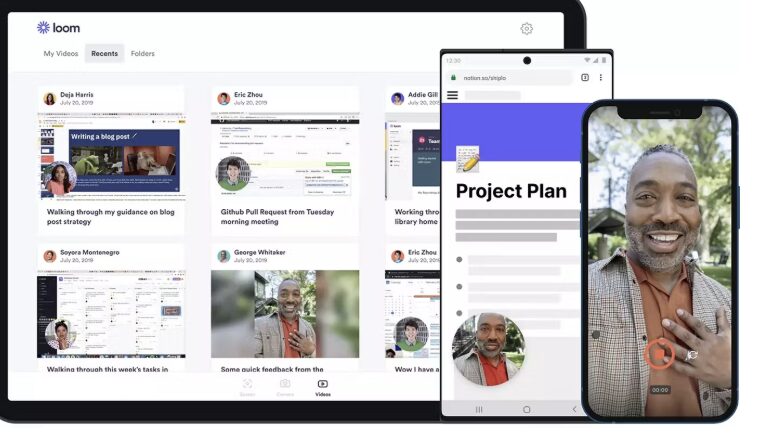
Loom is a video-first communication platform designed to reduce some of the back-and-forth of meetings and messages with easy, quick-to-record videos. It’s ideal for async updates, quick walkthroughs, visual feedback, or just putting a human face to remote work.
You can screen record, voice record, and camera record all at the same time with Loom, then share a link right away — no editing or uploading hassle required. It’s especially useful when you need to explain how something is done, explain ideas that are hard to put into words, or provide feedback on a design or document.
Audiences are able to respond through comments, emoji reactions, or even video replies, so the discussion can keep going without requiring everyone to be online at the same time. The tool works across desktop, mobile, and browser extensions, with integrations available for Slack, Gmail, Jira, and more.
But Loom is not a full-fledged communication system. It doesn’t offer chat, task management, threaded discussion, or team channels. While it reduces the need for live meetings, it doesn’t fully replace a system for everyday collaboration. It also works best for teams already accustomed to async workflows — ones that don’t need constant real-time interaction.
One more limitation: while free and business plans offer sufficient flexibility, larger teams that need admin controls, security, and SSO will need to move up to an enterprise plan.
That said, Loom is quite excellent at its job. It adds a human touch to async communication and makes it easy to explain difficult ideas without having to schedule yet another meeting. When paired with other collaboration tools, Loom becomes a useful piece of a modern communications stack.
Comparison of office communication systems
| Tool | Strengths & Fit | Limitations | Pricing (per user/mo, approximate) |
| Chanty | Unified chat, audio & video calls, landline calling, Kanban, intuitive UI, secure | Smaller ecosystem of native integrations | Free (up to 5 members, 10 integrations, 20 GB/team); Business $3 (annual) / $4 (monthly)Enterprise: custom |
| Slack | Rich features, excellent integrations, performant search, threaded chat | Notification fatigue, free tier limits history and integrations | Free; Pro $8; Business+ $12.50; Enterprise via quote |
| Microsoft Teams | Deep Microsoft 365 integration, secure, hybrid-ready, familiar UI | Can feel heavy; complex notifications; less flexible outside MS ecosystem | Teams Essentials $4.8;Business Basic $6;Standard $12.50 (annual) |
| Google Workspace | Lightweight, who rely on Gmail/Drive; strong unified search | Chat feature is basic; less threading and customization | Starter $6; Standard $12; Plus $18 (new since Mar 2025) |
| Twist | Thread-focused, asynchronous productivity, low noise | No voice/video built-in; slower conversations | Free; Pro $5 (annual billing) |
| Mattermost | Open-source, self-hosted, secure, tech integrations | Technical setup needed; less polished mobile/Desktop UI | Free; Professional $10; Enterprise via quote |
| Rocket.Chat | Self-hosted/cloud, secure, omnichannel, encryption options | Requires setup; UI less refined; fewer integrations | Starter self-hosted free;Pro $4;Enterprise via quote |
| ClickUp Chat | Context-rich chat tied to tasks/docs; reduces app-switching | No video/audio calling; lacks threading | Included in ClickUp plans from $5+ (chat bundled) |
| Notion | Flexibly organized chats, docs, knowledge base; excellent for async | No live chat or calling; setup requires structure | Free; Plus $12; Business $20; AI add-on varies |
| Loom | Fast video messaging, visual async updates, strong Slack/gmail integration | Not full communication platform; best as supplement | Free; Business/AI $8;Enterprise via quote |
Wrapping up
By now, it’s clear that a communication system isn’t a luxury. It’s the lifeblood of how today’s teams stay in sync, engaged, and in control. The search for the right tool often starts with frustration — endless email chains, too many tools with redundant features, constant notifications that somehow still fail to hit the mark. And with more teams working remotely or across time zones, the disconnect is only more acute. Humans forget what’s going on. Tasks fall through the air. Momentum is lost.
And then there’s the security factor. Sensitive project data, internal communications, client data — it all needs to be kept under lock and key. No business wants to have to deal with the risk of losing key details or not knowing where that document ended up. And the minute you’re working with a group, you want a tool that gives you visibility and control, without the anxiety of micromanagement.
So, teams begin looking for something more intuitive. Something that connects the dots, keeps things flowing, protects what’s essential, and makes people feel engaged again. Something that brings everything — chat, meetings, tasks, documents — together in one place, without the noise or clutter.
Whether you need a full-featured hub or something lighter, the tools we’ve covered offer different paths to a more connected workplace. And the right one is founded upon your workflow, your team, and how you get things done most efficiently. And if you do need an intelligent, adaptive system that keeps everything organized — whether your team is in the office or spread out across the world — we at Chanty are always here to make your communication and collaboration easier, less stressful, and more productive.



